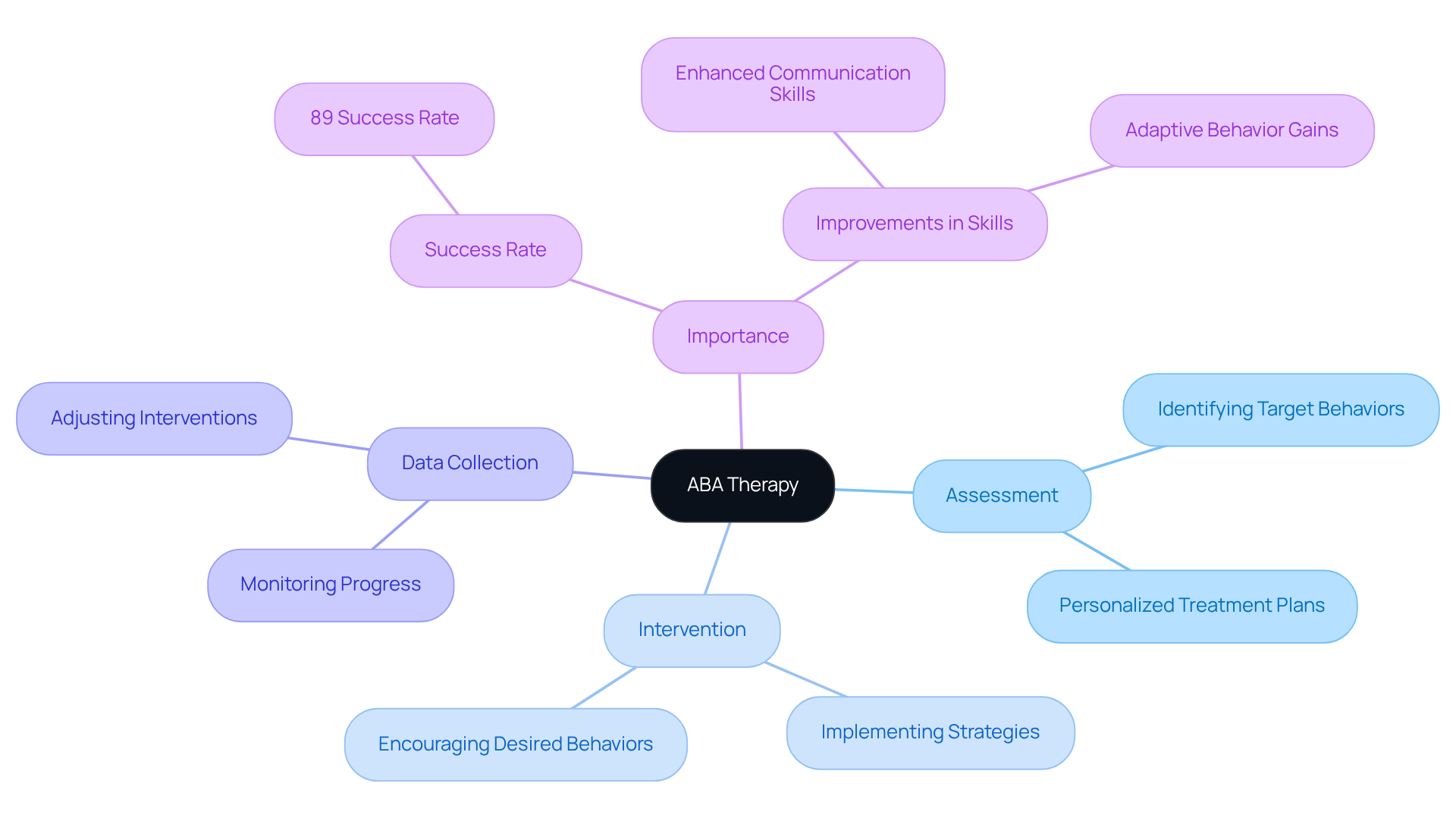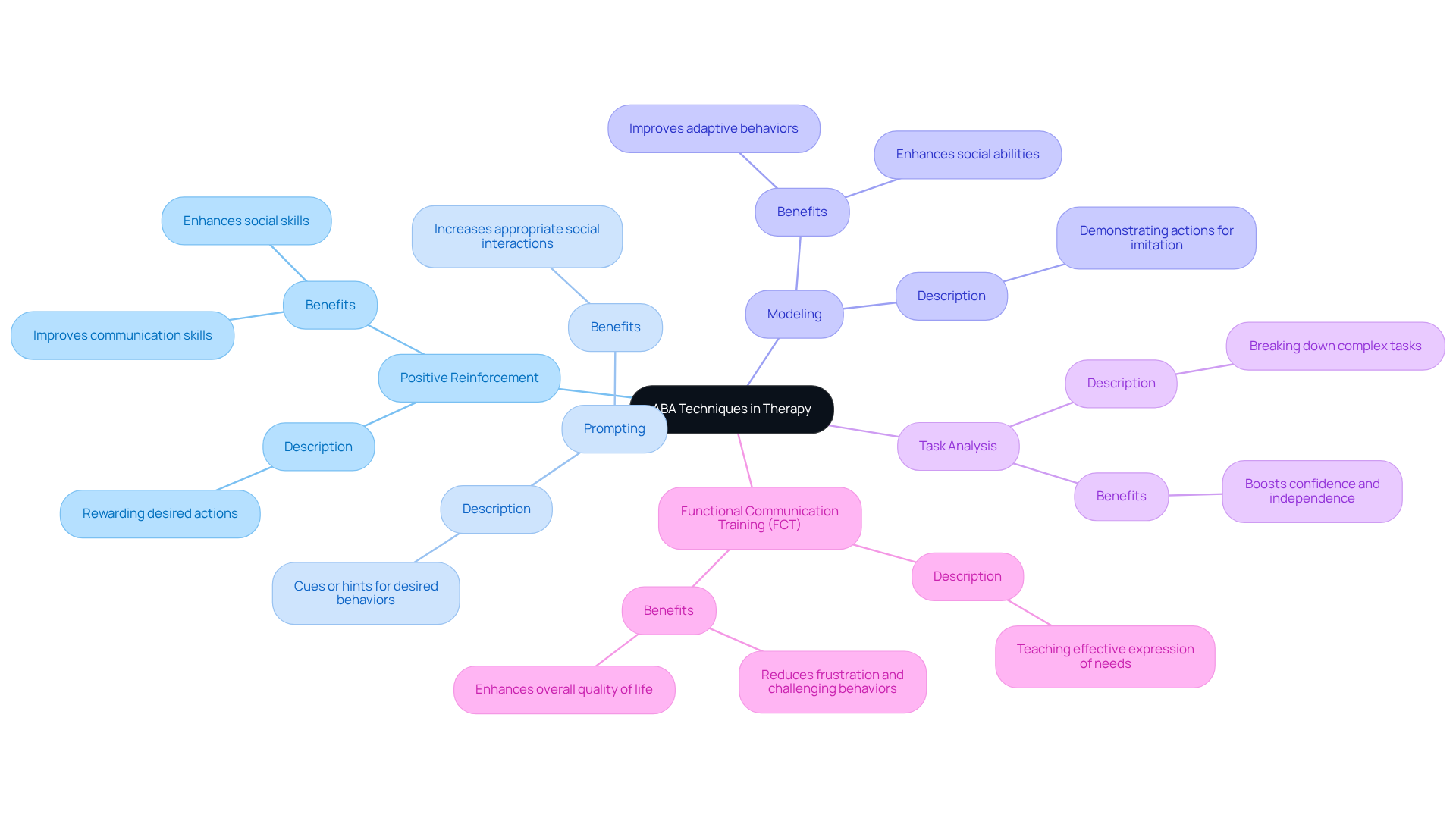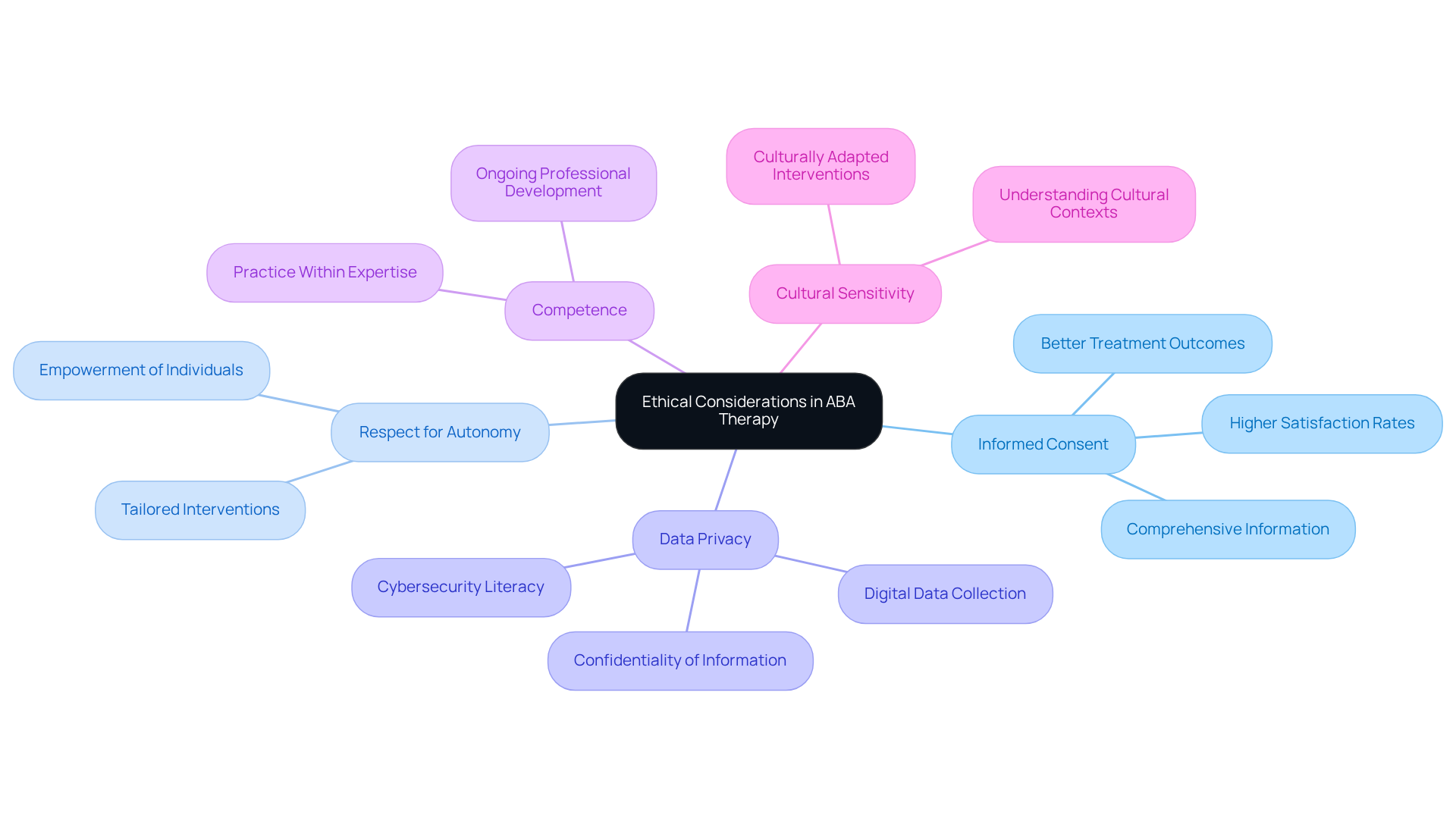Overview
ABA counseling plays a crucial role in supporting parents as they navigate the journey of aiding their children with autism. By employing essential techniques and ethical insights, this approach not only enhances communication and social skills but also fosters positive developmental outcomes. Imagine the relief of knowing that through personalized interventions, you can make a significant difference in your child’s life.
The article highlights the importance of adhering to ethical principles, such as informed consent and respect for autonomy. These principles are not just guidelines; they are the foundation that empowers you as a parent. By understanding and implementing these practices, you can create a nurturing environment that encourages your child's growth and development.
As you explore the world of ABA counseling, consider how these strategies can be tailored to meet your child’s unique needs. Each child is different, and personalized interventions can lead to remarkable improvements. It’s essential to feel confident in the support you provide, knowing that you are equipped with the right tools and understanding.
We invite you to share your experiences and thoughts in the comments or through our newsletters. Your journey is valuable, and by connecting with others, you can find both support and inspiration. Remember, you are not alone in this; together, we can foster a brighter future for our children on the autism spectrum.
Introduction
ABA counseling has become a vital support for individuals with autism, providing a structured approach to improve communication and social skills while addressing challenging behaviors. This article explores essential techniques and ethical insights related to ABA therapy, equipping parents with valuable knowledge to guide their child's therapeutic journey.
Yet, as families seek effective support, they often face complexities and ethical dilemmas that raise important questions:
- How can parents ensure they are making informed choices about their child's therapy?
- What ethical considerations should inform their decisions?
By exploring these aspects, we not only empower parents but also create a nurturing environment for their child's growth and development.
Define ABA Therapy and Its Importance for Autism Support
ABA counseling stands as a scientifically validated intervention designed to enhance specific actions and skills in individuals with autism and related disorders. By applying behavioral concepts, ABA not only promotes positive actions but also works to decrease those that may hinder learning and growth. ABA counseling is crucial for autism support, as it significantly enhances communication and social skills, while addressing challenging behaviors that can impede progress. Through data-driven methods, ABA counseling practitioners customize interventions to meet each individual's unique needs, creating an environment that fosters growth and learning. This personalized approach empowers parents and professionals alike to effectively support children on the autism spectrum.
Key components of ABA therapy include:
- Assessment: Identifying specific behaviors to target for improvement.
- Intervention: Implementing strategies through ABA counseling to encourage desired behaviors.
- Data Collection: Monitoring progress with ABA counseling to adjust interventions as needed.
Understanding these components is essential for parents who wish to engage meaningfully in their child's treatment journey and advocate for their needs effectively. Recent research indicates that ABA counseling has an impressive success rate of over 89% in enhancing communication skills, supported by numerous studies. Children participating in these programs demonstrate substantial improvements in both expressive and receptive language capabilities, with pooled effect sizes of 1.48 and 1.47, respectively. For instance, kids involved in intensive ABA programs have shown remarkable advancements in their ability to communicate effectively in daily scenarios. As highlighted by ASD Media, the primary objective of ABA counseling is to enhance social, communication, and adaptive abilities, enabling children to lead more independent and fulfilling lives. This evidence underscores the importance of ABA counseling as a cornerstone of support for families navigating the complexities of autism. Furthermore, it is vital to acknowledge the potential challenges in accessing ABA therapy services, which can impact families' ability to obtain the necessary support.

Outline Educational and Certification Pathways for ABA Therapists
Becoming an effective ABA therapist is a journey that involves a structured educational and certification pathway, essential for those looking to provide ABA counseling to support children with autism and ADHD. Let's explore the steps involved in this important process:
-
Educational Requirements: Most ABA therapists begin their journey with at least a bachelor’s degree in psychology, education, or a related field. Pursuing advanced degrees, such as a master’s or doctoral degree in behavior analysis or psychology, is often preferred, as it provides deeper insights into the principles and practices that guide effective conduct.
-
Certification: Once education is complete, aspiring therapists must obtain certification from recognized organizations, including the Behavior Analyst Certification Board (BACB). This crucial step involves passing the Board Certified Behavior Analyst (BCBA) exam, which evaluates knowledge and competency in ABA counseling practices.
-
Supervised Experience: Candidates are required to complete a specified number of supervised hours—typically between 1,500 to 2,000—under the guidance of a qualified BCBA. Many states also mandate additional hands-on clinical experience, usually exceeding 1,000 hours. This practical experience is vital for honing skills and understanding the nuances of behavior analysis in real-world settings.
-
Continuing Education: To uphold their certification, ABA therapists must engage in ongoing professional development, completing at least 32 continuing education hours every two years, with a minimum of 4 hours dedicated to ethics. This commitment to lifelong learning ensures that therapists remain informed about the latest research and best practices in the field.
Understanding these pathways is essential for parents when selecting qualified professionals for ABA counseling to ensure their children receive the highest standard of care. With over 33,633 ABA therapists currently employed in the U.S. and a 17% increase in demand for Board Certified Behavior Analysts (BCBA) professionals from 2019 to 2020, the need for certified professionals is on the rise. Furthermore, ABA counseling is utilized in 90% of cases in the United States, highlighting its effectiveness in improving outcomes for children with autism and ADHD. The average salary for BCBAs hovers around $60,000, providing insight into the financial aspects of hiring qualified professionals.
As you navigate this journey, remember that understanding these qualifications can empower you to make informed decisions for your child's future.

Explore Common ABA Techniques and Their Applications in Therapy
ABA counseling employs various methods aimed at fostering positive change, each uniquely designed to enhance a young person's development. Understanding these techniques can empower parents to support their children effectively. Here are some key strategies:
-
Positive Reinforcement: This approach involves rewarding desired actions to encourage their repetition. For instance, a young person might receive praise or a small reward for completing a task, motivating them to continue the behavior. Research shows that consistent use of positive reinforcement can significantly improve communication and social skills in individuals with autism. As highlighted by the Apricott team, 'ABA counseling has been proven to be effective in improving communication, social skills, and overall functioning in individuals with autism.'
-
Prompting: This technique offers cues or hints to assist a young individual in performing desired behaviors. For example, a therapist may use verbal prompts to encourage a young person to say 'thank you' after receiving help. Data indicates that effective prompting can greatly increase the likelihood of appropriate social interactions, underscoring its importance in therapy.
-
Modeling: This strategy involves demonstrating an action for the young person to imitate. A therapist might showcase suitable social interactions during playtime, allowing the child to learn through observation. This method has been shown to enhance social abilities and adaptive behaviors in young individuals.
-
Task Analysis: This approach breaks down complex tasks into smaller, manageable steps, making it easier for young individuals to learn essential daily living skills, such as brushing their teeth or getting dressed. By simplifying tasks, children can achieve success more readily, which boosts their confidence and independence.
-
Functional Communication Training (FCT): This method teaches young individuals how to express their needs effectively, which can reduce frustration and challenging behaviors. By equipping children with the tools to articulate themselves, FCT fosters improved interactions and enhances overall quality of life.
Understanding these techniques enables parents to reinforce learning at home and collaborate effectively with therapists, ultimately supporting their children's growth and development. It's also crucial to note that children who receive ABA counseling before the age of five show significant improvements in communication, social skills, and adaptive behaviors compared to those who start later, highlighting the importance of early intervention. Additionally, hybrid ABA treatment models that combine traditional techniques with complementary methods can enhance outcomes, providing greater accessibility and personalized care.

Discuss Ethical Considerations and Challenges in ABA Therapy
Ethical considerations in ABA practices are essential for ensuring that interventions are respectful, effective, and aligned with the best interests of the individual. Parents deserve to feel confident in the therapy their child receives, and understanding key ethical principles can help foster that trust.
-
Informed Consent is a cornerstone of ethical practice. Parents must receive comprehensive information about the therapy process, including its goals, methods, and potential risks. Research shows that families who receive thorough informed consent information report higher satisfaction with ABA counseling services and better treatment outcomes. This transparency enables them to make informed decisions regarding their child's treatment, which is crucial for building trust and satisfaction with the services provided.
-
Respect for Autonomy is equally vital. Therapists should honor the young person's preferences and individuality, tailoring interventions to meet their unique needs and circumstances. This regard for autonomy not only boosts involvement but also fosters a sense of agency in the young individual, empowering them in their therapeutic journey.
-
Data Privacy is paramount in maintaining a trusting therapeutic relationship. Safeguarding the confidentiality of the young person's information is essential. Approximately 78% of ABA providers now utilize some form of digital data collection, highlighting the importance of responsible data management in ABA counseling. Ensuring that information is shared only with authorized individuals protects the privacy of the individual and fosters trust.
-
Competence is another critical ethical principle. ABA therapists are required to practice within their areas of expertise and continually pursue professional development. The Behavior Analyst Certification Board (BACB) mandates ongoing continuing education for all certified practitioners, emphasizing that this commitment to ongoing education is vital for maintaining high standards of care and addressing the evolving challenges in the field.
-
Lastly, Cultural Sensitivity plays a significant role in effective interventions. Understanding and respecting the cultural backgrounds of families is crucial for delivering appropriate care. Research indicates that culturally adapted ABA interventions show improved outcomes and higher family engagement rates compared to standardized approaches, highlighting the importance of cultural competence in practice.
By addressing these ethical considerations, parents can feel assured of the integrity of the therapy their child receives, fostering a collaborative and trusting relationship with their ABA counseling professionals. If you have experiences or thoughts to share, please consider engaging with us in the comments or through our newsletters. Your voice matters in this journey.

Conclusion
ABA counseling is an invaluable resource for parents and professionals who support children with autism. It emphasizes the importance of personalized, data-driven interventions that enhance communication, social skills, and overall development. By understanding the principles and techniques of ABA therapy, families can actively participate in their children's growth while advocating for their unique needs.
The article highlights key components of ABA therapy, such as:
- Assessment
- Intervention
- Data collection
These are essential for tracking progress and tailoring approaches to each child’s needs. It also outlines the educational and certification pathways necessary for becoming a qualified ABA therapist, underscoring the growing demand for certified professionals in this field. Techniques like positive reinforcement, prompting, and functional communication training illustrate how effective strategies can foster positive behavioral changes in children.
Ultimately, the significance of ethical considerations in ABA therapy cannot be overstated. By prioritizing informed consent, respect for autonomy, data privacy, and cultural sensitivity, practitioners can build trust with families and ensure that interventions align with the best interests of the child. Engaging in this journey empowers parents and contributes to a broader understanding of effective, ethical practices in ABA therapy.
As the demand for these services continues to rise, it is crucial for families to remain informed and proactive in seeking the best support for their children on the autism spectrum. Together, we can create a community that understands and nurtures the unique needs of every child.
Frequently Asked Questions
What is ABA therapy and why is it important for autism support?
ABA therapy, or Applied Behavior Analysis therapy, is a scientifically validated intervention designed to enhance specific actions and skills in individuals with autism and related disorders. It promotes positive behaviors and reduces those that may hinder learning and growth, making it crucial for autism support.
What are the key components of ABA therapy?
The key components of ABA therapy include Assessment (identifying specific behaviors to target for improvement), Intervention (implementing strategies to encourage desired behaviors), and Data Collection (monitoring progress to adjust interventions as needed).
How does ABA therapy benefit communication skills in children with autism?
Recent research indicates that ABA therapy has a success rate of over 89% in enhancing communication skills. Children in these programs show substantial improvements in both expressive and receptive language capabilities, with effect sizes of 1.48 and 1.47, respectively.
What improvements can children expect from intensive ABA programs?
Children involved in intensive ABA programs have demonstrated significant advancements in their ability to communicate effectively in daily scenarios, enhancing their social and communication skills.
What is the primary objective of ABA counseling?
The primary objective of ABA counseling is to enhance social, communication, and adaptive abilities, enabling children to lead more independent and fulfilling lives.
What challenges might families face in accessing ABA therapy services?
Families may encounter potential challenges in accessing ABA therapy services, which can impact their ability to obtain the necessary support for their children on the autism spectrum.




